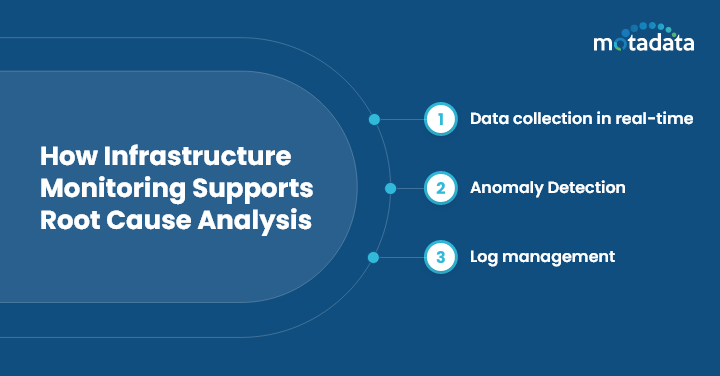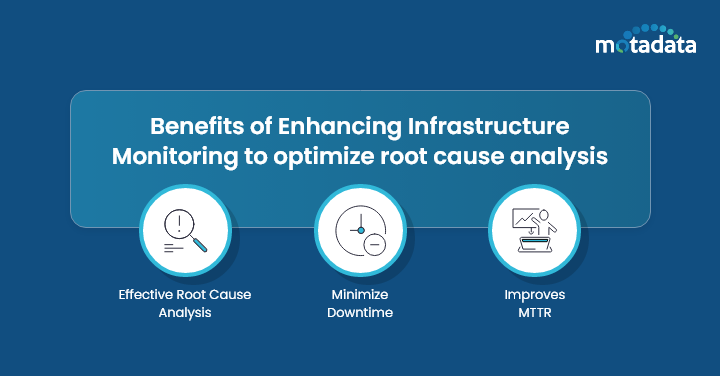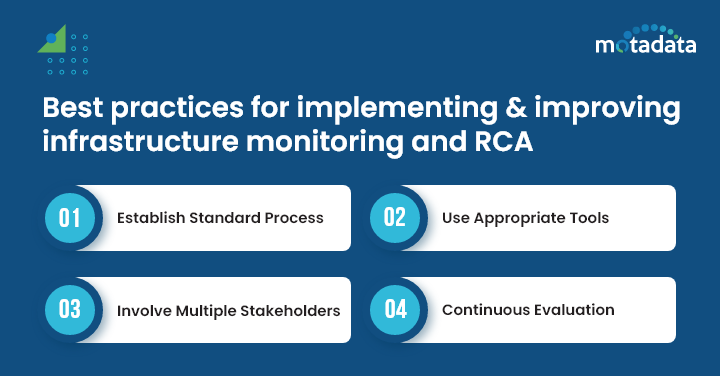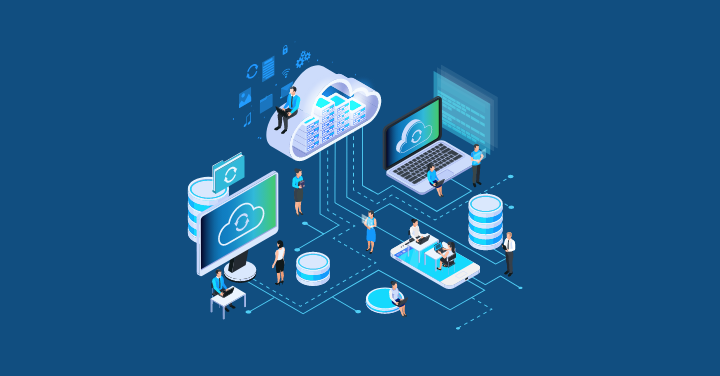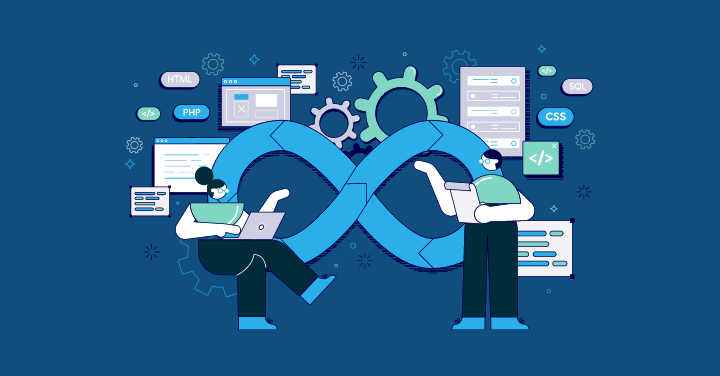One basic thing essential to running anything without conundrums is ‘CLARITY.’
Yes, whether you are finding a solution to the problem or digging down deep to find its root cause, it will not yield the desired results if you don’t have clarity in your process.
Especially in today’s data-driven economy, where bigger networks are the ‘need of the hour’ for organizations, advanced root cause analysis will save time and enhance the consumer experience.
This is why more than 90% of organizations are using or inclined to use the best technologies to deliver optimal performance and stay ahead of the competition.
Maintaining a consistent network infrastructure performance is quite a task in today’s digital age.
The requirements for high amounts of data, intricate network structures, and integration with different environments complicate the data gathering and analysis processes.
Nevertheless, the integration of root cause analysis into infrastructure monitoring has its advantages, which consist of increased productivity in problem-solving and aspirations to prevent problems before they occur.
Understanding Infrastructure Monitoring Systems
Infrastructure monitoring systems involve gathering and evaluating data about the IT infrastructure, systems, and processes to improve business results. It entails tracking different facets like the CPU, disks, networks, and performance benchmarks.
In doing so, organizations can guarantee their IT provision and continuing functionality to meet business needs and user satisfaction.
Network monitoring needs a tool to pull data from the network equipment and other networks to create a round view of the system state.
The Role of Root Cause Analysis in Infrastructure Health
Root cause analysis is very important to retain the condition and efficiency of IT assets.
It refers to finding out the root causes of problems or events that affect the system’s functioning.
By conducting a thorough analysis, organizations can pinpoint the root cause of problems:
They may be due to hardware failure or malfunction, improper software installation or configuration, a network breakdown, or an application problem.
This helps quickly identify the source of a problem & rectify it; hence, there will be less disruption of the end users’ activities.
Root cause analysis is crucial in infrastructure monitoring because it enables organizations to uphold a sound and reliable infrastructure to support their IT needs.
What is Root Cause Analysis?
Root cause analysis is a methodical approach that helps find the actual cause behind an incident, resulting in quick problem resolution.
Problems or faults usually occur due to a series of events.
By running a root cause analysis, team members can investigate these events and find the primary cause contributing to the major fault.
This technique is not restricted to just treating the symptom but finding the root cause of the problem.
Unlike the surface-level analysis, this practice includes many steps to find the actual cause. Further, it lets you spot other weak points and system vulnerabilities during the analysis.
This approach also helps users reduce downtime and improve the overall efficiency of their operations and performance.
Importance of RCA in Preventing Issues and Optimizing Performance
System issues and errors can impact a business’s performance and frustrate customers, resulting in huge losses and bad goodwill.
Hence, incorporating the practice of root cause analysis is important in businesses as it helps address the underlying cause of a problem and enables team members to implement effective solutions.
Every organization wants to maximize its performance, and root cause analysis is a useful tool for doing that.
Organizations can easily find the cause of process breakdowns or inefficiencies by investigating the issue and possible sources.
As a result, organizations can troubleshoot the issues and increase their performance through process optimization.
How Infrastructure Monitoring Supports Root Cause Analysis
An infrastructure monitoring system provides insights into the functionality and condition of all infrastructure components, which can be used to run RCA successfully.
The approach helps better understand the behavior of each system, which assists in identifying and resolving issues.
Here are the different ways in which infrastructure monitoring supports RCA.
Data collection in real-time
The monitoring tool allows team members to gain deeper insights into the system metrics, events, and behavior in real time.
Team members can quickly locate the issue and identify patterns indicating root causes by examining and visualizing this information using charts and graphs.
Anomaly Detection
System administrators can configure alert systems with predefined threshold limits that notify them when service disruptions occur, or resource utilization exceeds the set limit.
The alert option sends timely notifications to the team so they can find and address potential root causes of an issue before they impact the performance.
Log management
Logs play a key role in ensuring successful RCA. Log files are plain text records that include all events and operations that take place within a system.
Infrastructure monitoring systems come with log management capabilities that can be used to uncover the relation between systems and trace the events responsible for incidents, thus helping to find the root cause of the problem.
Impact of Ineffective Monitoring on Root Cause Analysis
Ineffective monitoring can affect the total quality management of the root cause analysis process, making it more difficult for organizations to identify potential real-time problems and prevent them from resolving faster.
Further, organizations cannot obtain the valuable insights required for continuous improvement programs due to ineffective monitoring, which functions as a barrier.
Poor monitoring can also result in incomplete analysis and a lack of process improvement.
Organizations without a thorough monitoring system could miss important information, making it challenging to identify the underlying source of problems.
Inadequate monitoring can also cause a lack of visibility, resulting in unsolved issues that keep coming up. Additionally, it will be difficult to analyze and identify the contributing factors accurately.
Hence, to address these problems, companies must invest in efficient monitoring systems that guarantee appropriate visibility and data collection.
Organizations can ensure successful root cause analysis and deliver better performance by implementing these practices.
Challenges of Enhancing Infrastructure Monitoring to optimize root cause analysis
Several challenges come with infrastructure monitoring systems and optimizing root cause analysis, such as:
Integration with other Monitoring Tools—Several monitoring and analytics tools are available on the market that organizations rely on to deliver better results and performance.
However, each of these monitoring tools has its own metrics and statistics. As a result, it can be difficult to integrate various technologies and extract pertinent insights.
So, businesses must carefully plan and strategize the whole process and ensure proper coordination.
Deeper Insights into Sequence of Events—It is essential to get a clear understanding of the sequence of events.
It is also important to know how these events have been affecting the issue so that users can determine the root cause.
Conversely, accurate event tracking and analysis can be difficult to achieve without a thorough monitoring system.
Users won’t be able to gain accurate data and insights from the inefficient monitoring system, which can also result in missing important metrics.
All this together may affect performance and result in a bad customer experience.
Benefits of Enhancing Infrastructure Monitoring to optimize root cause analysis
Several benefits to improving infrastructure monitoring include improved operational efficiency and efficient root cause analysis.
Let us take a deeper look into its benefits.
1. Effective root cause analysis
With an efficient infrastructure monitoring solution, businesses can identify patterns and unusual behavior in real time.
Also, it provides clear visibility into the health and status of the infrastructure in real-time which makes it easy to identify the potential errors causing the major impact.
2. Minimize Downtime
By identifying the issue in real-time, administrators can look into the faults and fix them in real time.
As a result, your chances of downtime will be reduced, and your customer satisfaction level will improve. More customers will return to your service, further improving productivity.
3. Improves Mean Time to Resolution (MTTR)
With RCA, the user treats the symptoms and understands and identifies the sequence of events.
By understanding the primary cause of the event, teams can plan for effective solutions and prevent similar events from happening again in the future.
Hence, reduce MTTR and improve the troubleshooting process.
Integration with other monitoring and analytics tools
With integration capabilities, organizations can enhance their infrastructure monitoring system and RCA processes as it will help gain a thorough understanding of their infrastructure.
Relying on a variety of technologies, businesses will be able to analyze and solve problems faster and more efficiently.
Integrating new monitoring tools will make collecting data from multiple sources easier and provide a holistic view of performance, patterns, trends, and potential root causes.
Several analysis tools are available on the market that organizations can use to improve their analysis procedures and make informed decisions.
Integration reduces manual efforts and offers more clarity to data, which contributes to successful root cause analysis.
Organizations can enhance their overall operational efficiency by leveraging the combined power of analytics and data monitoring through tool integration, resulting in more effective root cause analysis.
Best practices for implementing and improving infrastructure monitoring and RCA
Here are some of the best practices that a business must follow to conduct an effective root cause analysis:
Establish a standard process
It is essential to create a defined process that describes all the procedures, roles, and tasks involved in root cause analysis.
By documenting the framework, team members can easily run the process and implement a corrective action plan.
Use appropriate tools
Invest in the right tools to enhance the effectiveness of your root cause analysis procedure.
Invest in a tool that collects all the infrastructure data in real time, supports performing a thorough analysis, and visualizes the relationship between different components to find the primary cause.
Involve multiple stakeholders
The involvement of multiple stakeholders in infrastructure management is necessary for effective root cause analysis.
Their areas of expertise and diverse knowledge will help create a thorough picture of the issue and improve the chances of identifying the actual underlying cause.
Continuous Evaluation
IT environments are constantly evolving, so it is essential to ensure that your defined plan of action meets your goals and objectives.
Make sure to review your established monitoring strategy regularly to evaluate the results and check if the new plan of action is working towards improving the result.
Harness the power of the Motadata infrastructure Monitoring to optimize root cause analysis
Motadata Infrastructure Monitoring solution is one of the trusted AI-driven monitoring tools in the market. Most professionals use it to monitor different components of an IT infrastructure.
The tool helps team members perform real-time monitoring, data visualization, log indexing, and root cause analysis in real-time.
This full-stack monitoring and analytics tool can help businesses deliver better outcomes and improve customer experience.
It is an AI-powered platform that can monitor thousands of apps and devices, collect data from various sources, and offer deep visibility for quick analysis.
Further, organizations can reduce downtime and enhance user experience by promptly identifying possible core causes and taking prompt action by utilizing real-time analytics.
The monitoring features of Motadata also facilitate quality control and provide valuable insights into a company’s infrastructure.
This allows for continuous monitoring of processes, guaranteeing that problems are quickly found, examined, and fixed.
Organizations can increase overall operational efficiency and boost customer satisfaction by maintaining the quality of their infrastructure.
Root cause analysis plays a key role in achieving this goal as it helps find and fix problems in real-time, stops similar ones from happening again, and increases operational effectiveness.
Also, by integrating machine learning algorithms and infrastructure monitoring tools with other analytics tools, businesses may proactively address possible issues and identify anomalies.
Above, we have listed a few challenges and benefits of an infrastructure monitoring system and how to overcome hard situations with best practices.
FAQs
The machine learning algorithms help examine the historical data files, trace patterns, and identify any unusual behavior or inefficiency in the system.
Once it detects an issue, it informs the alert operations about the possibility of an escalation in the future.
This feature will considerably reduce the time needed for root cause analysis, as well as your efforts and the entire process.
However, it’s crucial to recognize these algorithms’ limitations and appropriately interpret the outcomes.
To enhance infrastructure monitoring capabilities, an organization must follow these best practices, including defining clear goals, regular monitoring and identification of problems, refining monitoring strategies, and following a systematic approach to locate the potential issues.
Any business can enhance its performance, maximize monitoring efforts, and successfully manage risk by adhering to these best practices.
The application of predictive analytics, artificial intelligence, cloud-based infrastructure monitoring systems, and machine learning techniques are a few emerging trends and changes in infrastructure monitoring and root cause analysis that can enhance overall quality management.
Further, these upcoming trends will help businesses automate root cause analysis and minimize downtime by anticipating possible problems.
Modern IT infrastructure must optimize root cause analysis since it facilitates the identification of problem root causes, stops issues from happening again, and promotes efficient problem-solving.
Further, complex IT environments can make the most of their resources, implement a strong strategy, and resolve issues in real-time, resulting in minimizing downtime and efficient problem-solving.


